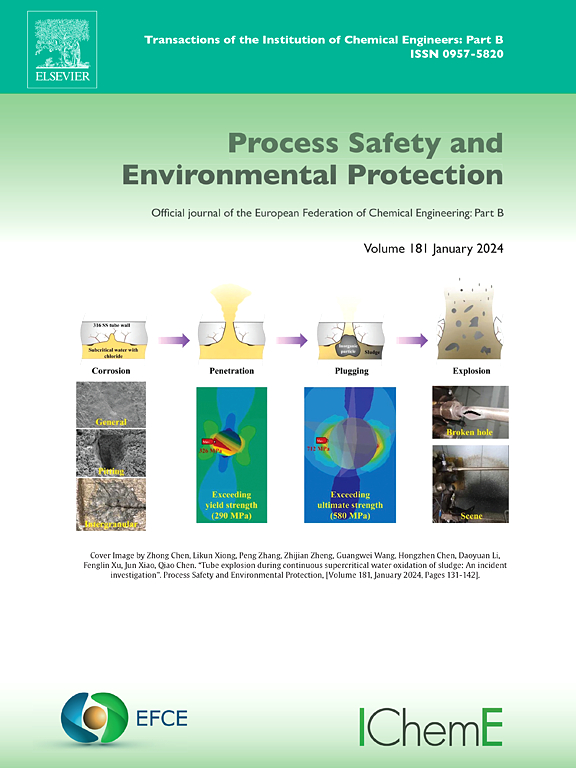Synergistic reutilization of industrial by-product GGBS and high-water-content dredged clay waste for sustainable backfilling materials
IF 6.9
2区 环境科学与生态学
Q1 ENGINEERING, CHEMICAL
引用次数: 0
Abstract
The extensive accumulation of dredged material waste and industrial by-product ground granulated blast-furnace slag (GGBS) has emerged as a critical environmental concern, necessitating the development of safe and sustainable management strategies for these wastes. This paper presents an experimental investigation on the evaluation of strength performance of high-water-content dredged clay treated with ground granulated blast-furnace slag (GGBS) for use as backfilling materials. A series of laboratory tests, including unconfined compressive strength (UCS) tests, direct shear (DS) tests, and scanning electron microscopy (SEM) analysis, were conducted to systematically evaluate the effects of GGBS dosage and curing time on the strength behavior of GGBS-treated dredged clay samples at varying water contents. The UCS test results indicate that all samples exhibited strain-softening behavior, with the unconfined compressive strength initially increasing and then decreasing as the GGBS content increased, peaking at an optimal dosage of 30 %. Additionally, the unconfined compressive strength consistently increased with curing time. A quantitative equation was developed to estimate the unconfined compressive strength of GGBS-stabilized dredged clay, at different curing times and water contents when the GGBS dosage is below 30 %. The DS test results demonstrate that, under a given vertical stress, the shear strength of the samples increases with both GGBS content within 30 % and curing time within 28d. The shear strength parameters, including cohesion and internal friction angle, also increased as the GGBS dosage ranged from 10 % to 30 % and the curing time extended from 3 h to 28d. Two quantitative equations were formulated to respectively estimate the cohesion and internal friction angle of GGBS-stabilized dredged clay samples at various GGBS contents from 10 % to 30 % and curing times 3 h to 28d. SEM analysis confirmed the formation of cementitious gels at higher values of GGBS dosage and longer curing time, resulting in a more uniform and denser microstructure in the treated dredged clay.
工业副产物GGBS与高含水率疏浚粘土废弃物协同再利用的可持续回填材料研究
疏浚材料废物和工业副产品磨粒高炉渣(GGBS)的广泛积累已成为一个严重的环境问题,需要为这些废物制定安全和可持续的管理战略。本文对高含水率疏浚粘土的强度性能评价进行了试验研究,该粘土采用磨碎的矿渣处理作为回填材料。通过无侧限抗压强度(UCS)试验、直剪(DS)试验和扫描电镜(SEM)分析等一系列室内试验,系统评价了GGBS掺量和养护时间对不同含水量下经GGBS处理的疏浚粘土样品强度行为的影响。UCS试验结果表明,所有试样均表现出应变软化行为,随GGBS含量的增加,无侧限抗压强度先升高后降低,在最佳掺量为30 %时达到峰值。随着养护时间的延长,无侧限抗压强度持续增加。建立了在GGBS掺量小于30% %时,不同养护时间和含水量下GGBS稳定泥的无侧限抗压强度定量方程。DS试验结果表明,在竖向应力一定的情况下,GGBS掺量在30% %以内,养护时间在28d以内,试样抗剪强度增大。随着GGBS掺量从10 %增加到30 %,固化时间从3 h增加到28d,粘聚力和内摩擦角等抗剪强度参数也有所增加。在GGBS含量为10 % ~ 30 %、养护时间为3 h ~ 28d的条件下,建立了两个定量方程,分别计算了GGBS稳定的泥质土样品的黏聚力和内摩擦角。SEM分析证实,较高的GGBS用量和较长的养护时间可形成胶凝凝胶,处理后的粘土微观结构更加均匀致密。
本文章由计算机程序翻译,如有差异,请以英文原文为准。
求助全文
约1分钟内获得全文
求助全文
来源期刊

Process Safety and Environmental Protection
环境科学-工程:化工
CiteScore
11.40
自引率
15.40%
发文量
929
审稿时长
8.0 months
期刊介绍:
The Process Safety and Environmental Protection (PSEP) journal is a leading international publication that focuses on the publication of high-quality, original research papers in the field of engineering, specifically those related to the safety of industrial processes and environmental protection. The journal encourages submissions that present new developments in safety and environmental aspects, particularly those that show how research findings can be applied in process engineering design and practice.
PSEP is particularly interested in research that brings fresh perspectives to established engineering principles, identifies unsolved problems, or suggests directions for future research. The journal also values contributions that push the boundaries of traditional engineering and welcomes multidisciplinary papers.
PSEP's articles are abstracted and indexed by a range of databases and services, which helps to ensure that the journal's research is accessible and recognized in the academic and professional communities. These databases include ANTE, Chemical Abstracts, Chemical Hazards in Industry, Current Contents, Elsevier Engineering Information database, Pascal Francis, Web of Science, Scopus, Engineering Information Database EnCompass LIT (Elsevier), and INSPEC. This wide coverage facilitates the dissemination of the journal's content to a global audience interested in process safety and environmental engineering.
 求助内容:
求助内容: 应助结果提醒方式:
应助结果提醒方式:


